weight CHEVROLET S10 1994 2.G Owners Manual
[x] Cancel search | Manufacturer: CHEVROLET, Model Year: 1994, Model line: S10, Model: CHEVROLET S10 1994 2.GPages: 340, PDF Size: 18.45 MB
Page 70 of 340
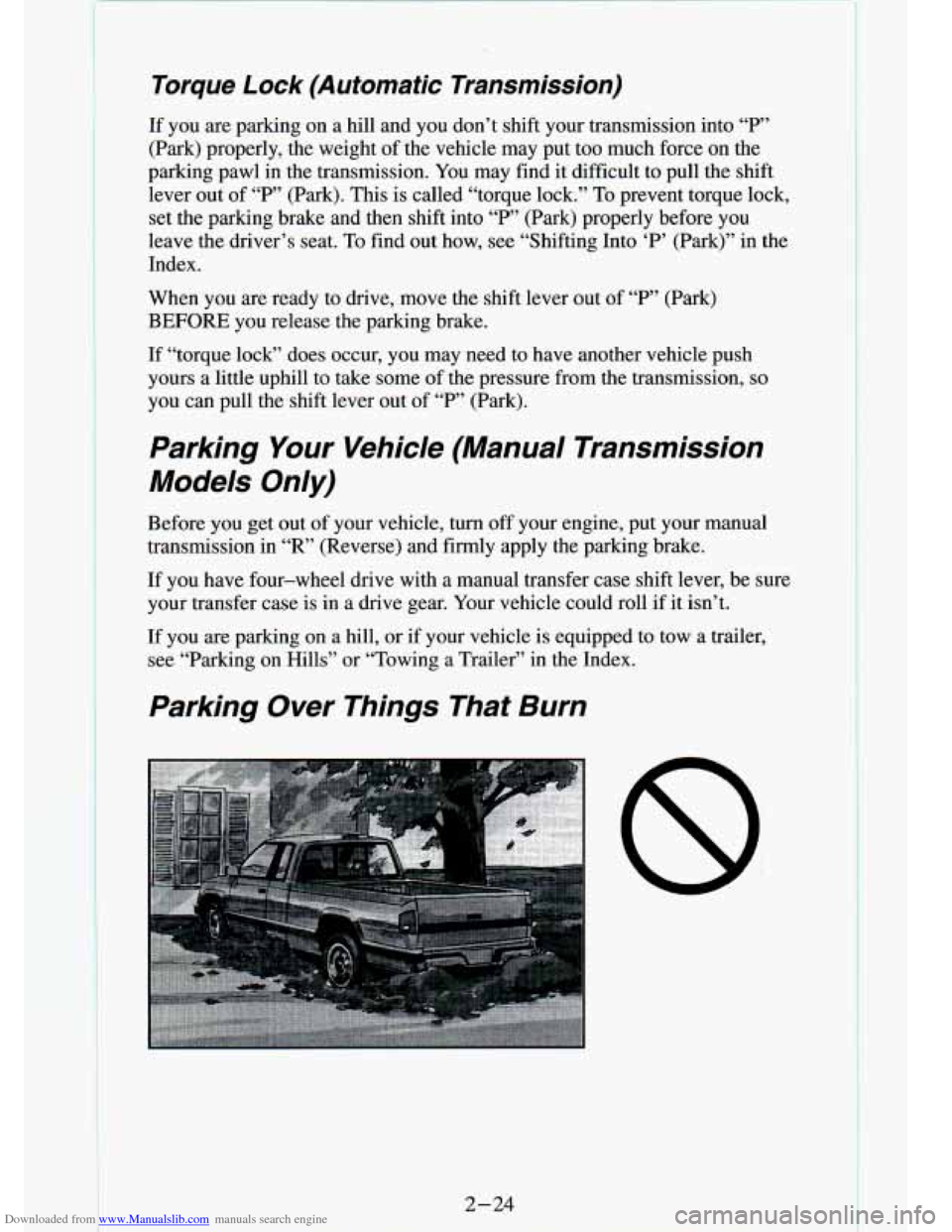
Downloaded from www.Manualslib.com manuals search engine Torque Lock (Automatic Transmission)
If you are parking on a hill and you don’t shift your transmission into “P’
(Park) properly, the weight of the vehicle may put too much force on the
parking pawl in the transmission. You may find it difficult to pull the shift
lever out of
“P” (Park). This is called “torque lock.” To prevent torque lock,
set the parking brake and
then shift into “P” (Park) properly before you
leave the driver’s seat.
To find out how, see “Shifting Into ‘P’ (Park)” in the
Index.
When you are ready to drive, move the shift lever out of
“P” (Park)
BEFORE you release the parking brake.
If “torque lock” does occur, you may need to have another vehicle push
yours a little uphill
to take some of the pressure from the transmission, so
you can pull the shift lever out of “P’ (Park).
Parking Your Vehicle (Manual Transmission
Models Only)
Before you get out of your vehicle, turn off your engine, put your manual
transmission in
“R’ (Reverse) and firmly apply the parking brake.
lr you have four-wheel drive with a manual transfer case shift lever, be sure
your transfer case is
in a drive gear. Your vehicle could roll if it isn’t.
If you are parking on
a hill, or if your vehicle is equipped to tow a trailer,
see “Parking on Hills” or “Towing
a Trailer” in the Index.
Parking Over Things That Burn
8
2- 24
Page 138 of 340
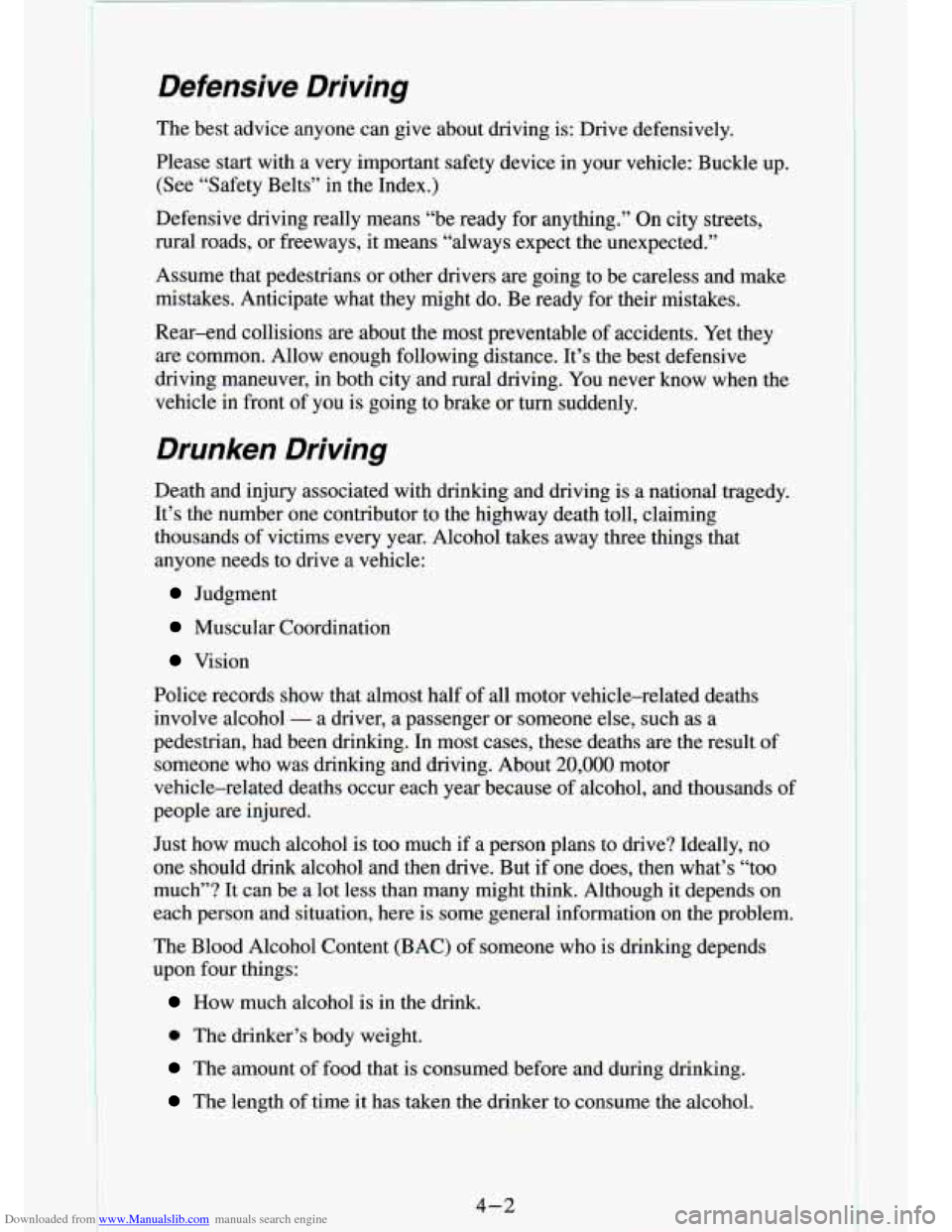
Downloaded from www.Manualslib.com manuals search engine Defensive Driving
:c. 1-
1 -- ,- -. , ..
The best advice anyone can give about driving is: Drive defensively\
,
Please start with a
very important safety device in your vehicle: Buckle up.
(See “Safety Belts”
in the Index.)
Defensive driving really means “be ready for anything.” On city streets,
rural roads, or freeways, it means “always expect the unexpected.”
Assume that pedestrians or other drivers are going to be carel\
ess and make
mistakes. Anticipate what they might do. Be ready for their mistakes.
Rear-end collisions are about the most preventable
of accidents. Yet they
are common. Allow enough following distance. It’s the best d\
efensive
driving maneuver, in both city and rural driving. You never know when the
vehicle
in front of you is going to brake or turn suddenly.
Drunken Driving
Death and injury associated with drinking and driving is a nat\
ional tragedy.
It’s the number one contributor to the highway death toll, \
claiming
thousands
of victims every year. Alcohol takes away three things that
anyone needs to drive a vehicle:
Judgment
Muscular Coordination
Vision
Police records show mar almost half
of all motor vehicle-related deaths
involve alcohol
- a driver, a passenger or someone else, such as a
pedestrian, had been drinking. In most cases, these deaths are \
the result of
someone who was drinking and driving. About
20,000 motor
vehicle-related deaths occur each year because of alcohol, and \
thousands
01
people are injured.
Just how much alcohol is too much if a person plans to drive\
? Ideally, no one should drink alcohol and then drive. But
if one does, then what’s “too
much”? It can be a lot less than many might think. Although it depends on
each person and situation, here is some.genera1 information
on the problem.
The Blood Alcohol Content (BAC)
of someone who is drinking depends
upon four things:
How much alcohol is in the drink.
0 The drinker’s body weight.
The amount of food that is consumed before and during drinking.
The length of time it has taken the drinker to consume the alcohol.
4-2
Page 158 of 340
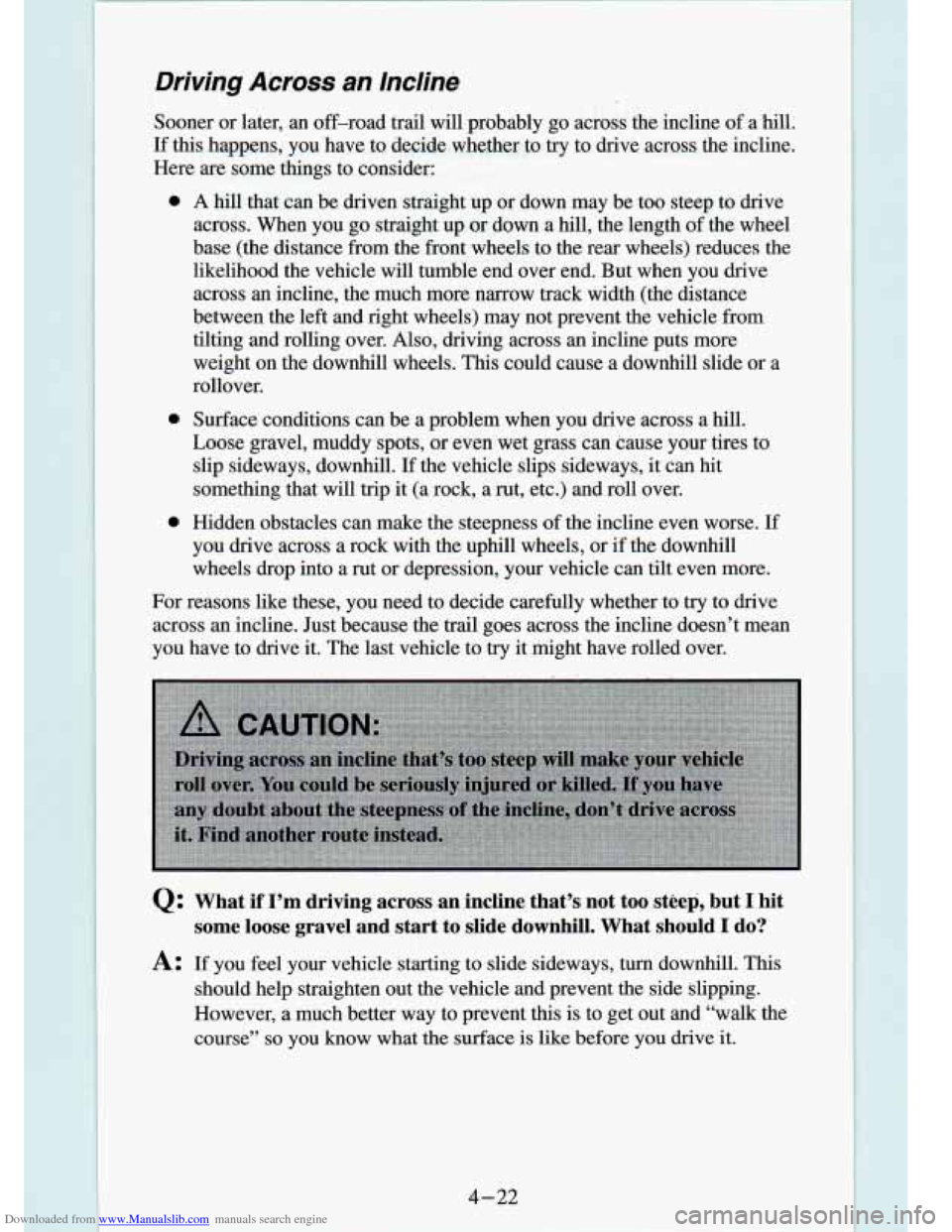
Downloaded from www.Manualslib.com manuals search engine Driving Across an Incline
Sooner or later, an off-road trail will probably go across the incline of a hill.
If this happens, you have to decide whether to try to drive across the incline.
Here are some things to consider:
(I,
0
0
A hill that can be driven straight up or down may be too steep to drive
across. When you
go straight up or down a hill, the length of the wheel
base (the distance from the front wheels to the rear wheels)\
reduces the
likelihood the vehicle will tumble end over end. But when you \
drive
across an incline, the much more nmow track width (the distance
between the left and right wheels) may not prevent the vehicl\
e from
tilting and rolling over.
Also, drivirig across an indline puts more
weight on the downhill wheels. This could cause a downhil slide or a
rollover.
Surface conditions can be
a problem when you drive across a hill.
Loose gravel, muddy spots, or even wet grass can cause your t\
ires to
slip sideways, downhill. If the vehicle slips sideways, it can hit
something that will trip it (a rock,
a rut, etc.) and roll over.
Hidden obstacles can make the steepness of the incline even worse.
I€
you drive across a rock with the uphill wheels, or if the do\
wnhill
wheels drop into a rut
or depression, your vehicle can tilt even more.
For reasons like these,
you need to decide carefully whether to try to drive
across an incline. Just because the trail goes across the incl\
ine doesn’t mean
you have to drive it. The last vehicle to
try it might have rolled over.
Q: What if I’m driving across an incline that’s not too ste\
ep, but I hit
A: If you feel your vehicle starting to slide sideways, turn downhill\
. This
should help straighten out the vehicle and prevent the side sl\
ipping.
However, a much better way to prevent
hs is to get out and “walk the
course”
so you know what the surface is like before you drive it.
some loose gravel and start to slide dowhhill. What should I do?
4-22
Page 175 of 340
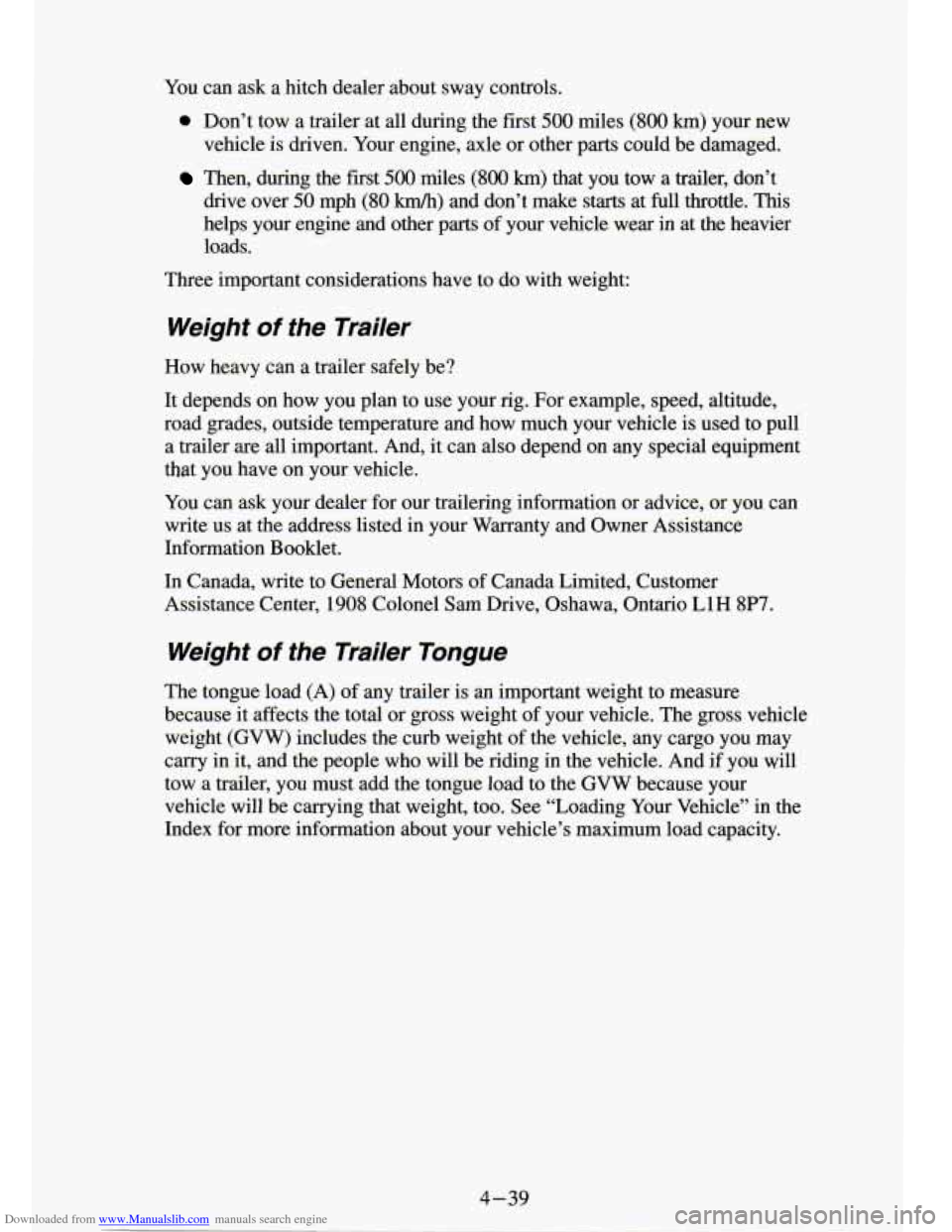
Downloaded from www.Manualslib.com manuals search engine You can ask a hitch dealer about sway controls.
0 Don’t tow a trailer at aU during the first 500 miles (800 km) your new
vehicle is driven. Your engine, axle or other
parts could be damaged.
Then, during the fist 500 miles (800 km) that you tow a trailer, don’t
drive over
50 mph (80 kmk) and don’t make starts at full throttle. This
helps your engine and other
parts of your vehicle wear in at the heavier
loads.
Three important considerations have to da with weight:
Weight of the Trailer
How heavy can a .trailer safely be?
It depends on how you plan to use your rig. For example, speed, altitude,
road grades, outside temperature and how much your vehicle is used to pull
a trailer are all important. And, it can also depend on any special equipment
that you have
on your vehicle.
You can ask
your dealer for our trailering information or advice, or you can
write us at the address listed
in your Warranty and Owner Assistance
Information Booklet.
In Canada, write to General Motors of Canada Limited, Customer
Assistance Center,
1908 Colonel Sam Drive, Oshawa, Ontario L1H 8P7.
Weight of the Trailer Tongue
The tongue load (A) of any trailer is an important weight to measure
because it affects the total or gross weight
of your vehicle. The gross vehicle
weight (GVW) includes the curb weight of the vehicle, any cargo you may
carry in it, and the people who will be riding in the vehicle. And
if you will
tow a trailer, you must add the tongue load to the GVW because your\
vehicle will be carrying that weight,
too. See “Loading Your Vehicle” in the
Index for more infomation about your vehicle’s maximum load capacity.
4-39
Page 176 of 340
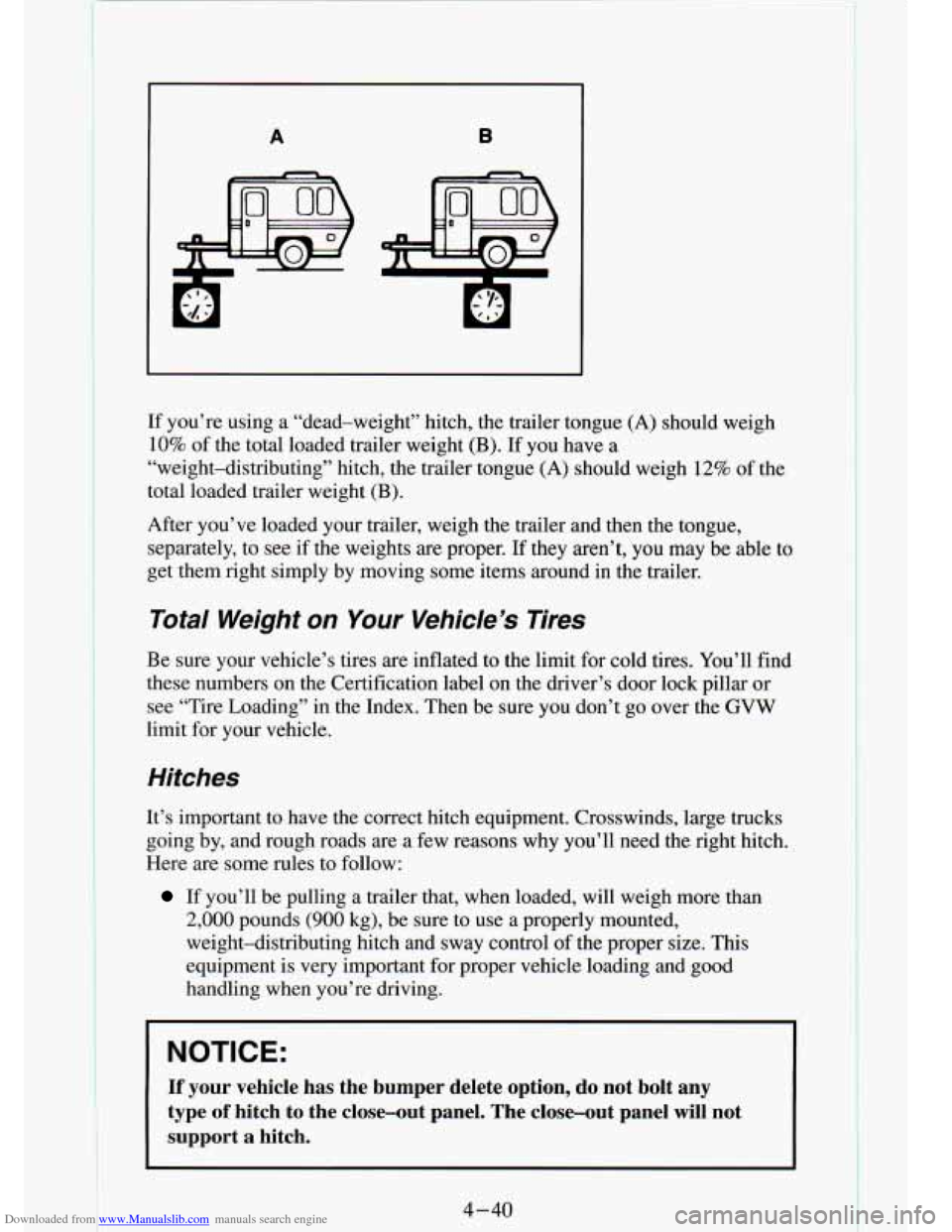
Downloaded from www.Manualslib.com manuals search engine A B
If you’re using a “dead-weight” hitch, the trailer tong\
ue (A) should weigh
10% of the total loaded trailer weight
(B). If you have a
“weight-distributing” hitch, the trailer tongue
(A) should weigh 12% of the
total loaded trailer weight (B).
After you’ve loaded your trailer, weigh the trailer and then\
the tongue, separately, to see if the weights are proper. If they aren’t,
you may be able to
get them right simply
by moving some items around in the trailer.
Total Weight on Your Vehicle’s Tires
Be sure your vehicle’s tires are inflated to the lirnit for cold tires. You’ll find
these numbers on the Certification label on the driver’s doo\
r lock pillar or
see “Tire Loading”
in the Index. Then be sure you don’t go over the GVW
limit for your vehicle.
Hitches
It’s important to have the correct hitch equipment. Crosswind\
s, large trucks
going by, and rough roads are a few reasons why you’ll nee\
d the right hitch.
Here are some rules to follow:
If you’ll be pulling a trailer that, when loaded, will weigh m\
ore than
2,000 pounds (900 kg), be sure to use a properly mounted,
weight-distributing hitch and sway control of the proper size. This equipment is very important for proper vehicle loading and good
handling when you’re driving.
NOTlCE:
If your vehicle has the bumper delete option, do not bolt any
type
of hitch to the close-out panel. The close-out panel will not
support
a hitch.
4-40
Page 177 of 340
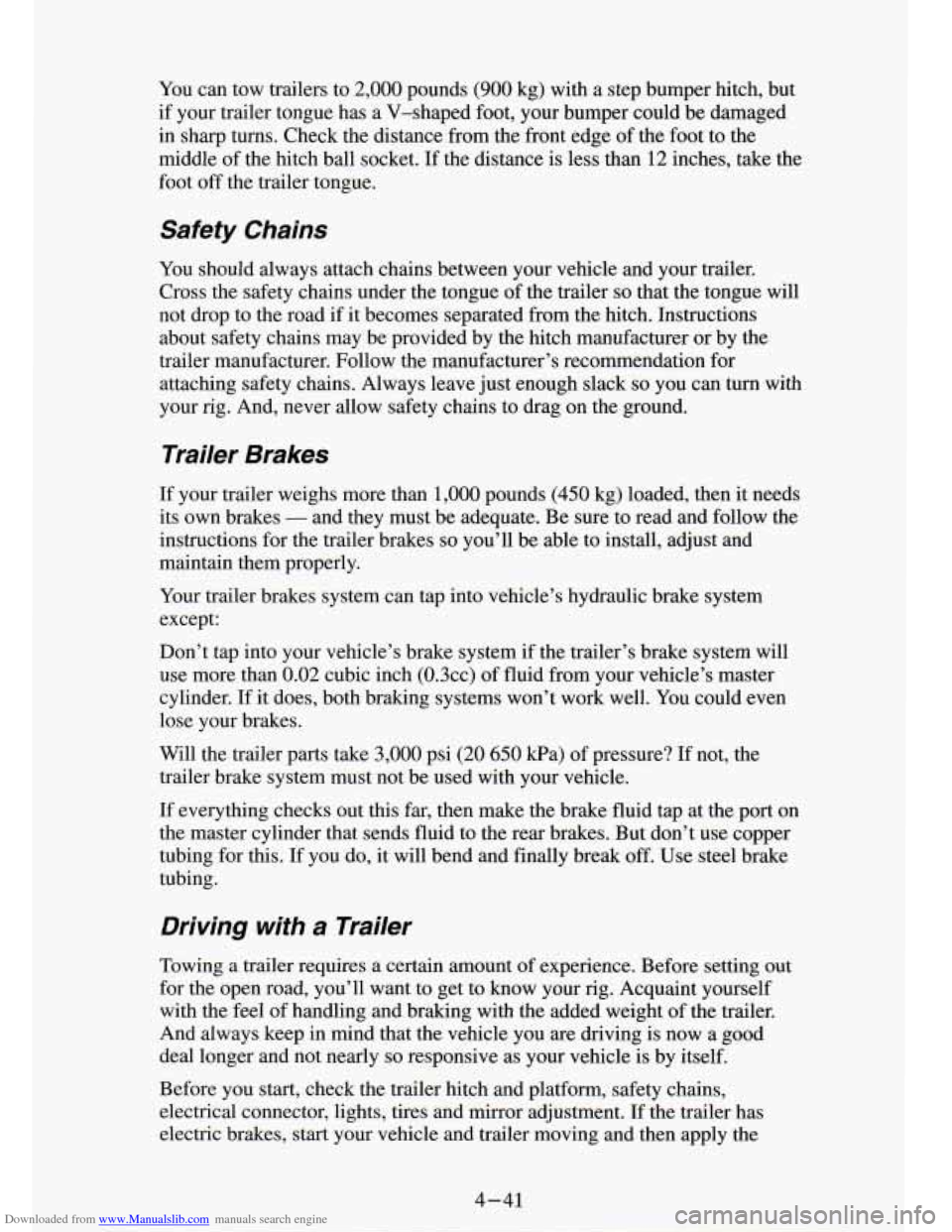
Downloaded from www.Manualslib.com manuals search engine You can tow trailers to 2,000 pounds (900 kg) with a step bumper hitch, but
if your trailer tongue has a V-shaped foot, your bumper could be damaged
in sharp turns. Check the distance from the front edge of the foot to the
middle of the hitch ball socket.
If the distance is less than 12 inches, take the
foot
off the trailer tongue.
Safety Chains
You should always attach chains between your vehicle and your trail\
er.
Cross the safety chains under the tongue of the trailer
so that the tongue will
not drop
to the road if it becomes separated from the hitch. Instructions
about safety chains may be provided by the hitch manufacturer \
or by the
trailer manufacturer. Follow the manufacturer’s recommendation for
attaching safety chains. Always leave just enough slack
so you can turn with
your rig. And, never allow safety chains to drag
on the ground.
Trailer Brakes
If your trailer weighs more than 1,000 pounds (450 kg) loaded, then it needs
its own brakes
- and they must be adequate. Be sure to read and follow the
instructions for the trailer bE---:s
so you’ll be able to install, adjust and
maintain them properly.
Your trailer brakes system can tap into vehicle’s hydraulic brake system
except:
Don’t tap into your vehicle’s brake system if the trailer’s brake system will
use more than
0.02 cubic inch (0.3~~) of fluid from your vehicle’s master
cylinder. If it does, both braking systems won’t work well. You could even
lose your brakes.
Will the trailer parts take
3,000 psi (20 650 Pa) of pressure? If not, the
trailer brake system must not be used with your vehicle.
If everything checks out this far, then make the brake fluid tap at the port on
the master cylinder that sends fluid to the rear brakes. But don’t use copper
tubing for this.
If you do, it will bend and finally break off. Use steel brake
tubing.
Driving with a Trailer
Towing a trailer requires a certain amount of experience. Before setting out
for the open road, you’ll want to get to know your rig. Acquai\
nt yourself
with the feel
of handling and braking with the added weight of the trailer.
And always keep
in mind that the vehicle you are driving is now a good
deal longer and not nearly
so responsive as your vehicle is by itself.
Before you start, check the trailer hitch and platform, safety chains,
electrical connector, lights, tires and mirror adjustment. If th\
e trailer has
electric brakes, start your vehicle and trailer moving and then\
apply the
4-41
Page 263 of 340
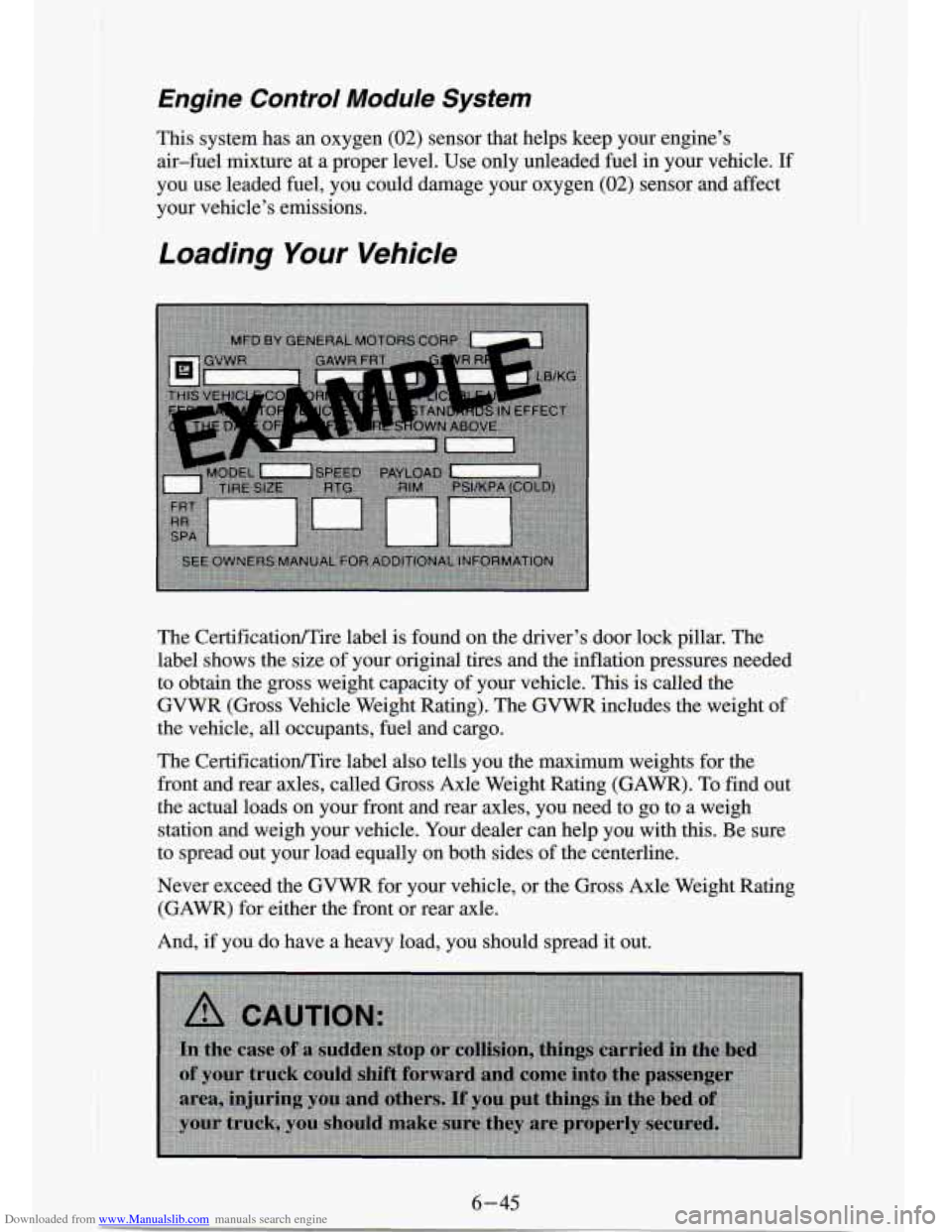
Downloaded from www.Manualslib.com manuals search engine Engine Control Module System
This system has an oxygen (02) sensor that helps keep your engine’s
air-fuel mixture at a proper level. Use only unleaded fuel in your vehicle.
If
you use leaded fuel, you could damage your oxygen (02) sensor and affect
your vehicle’s emissions.
Loading Your Vehicle
The CertificatiodTire label is found on the driver’s door lock pillar. The
label shows the size of your original tires and the inflation pressures needed
to obtain the
gross weight capacity of your vehicle. This is called the
GVWR (Gross Vehicle Weight Rating). The GVWR includes the weight of
the vehicle,
all occupants, fuel and cargo.
The CertificatiodTire label
also tells you the maximum weights for the
front and rear axles, called Gross Axle Weight Rating
(GAWR). To find out
the actual
loads on your front and rear axles, you need to go to a weigh
station and weigh
your vehicle. Your dealer can help you with this. Be sure
to spread out your load equally
on both sides of the centerline.
Never exceed the GVWR for your vehicle, or the Gross Axle Weight Rating
(GAWR) for either the front or rear axle.
And, if you do have a heavy load, you should spread it out.
6-45
Page 264 of 340
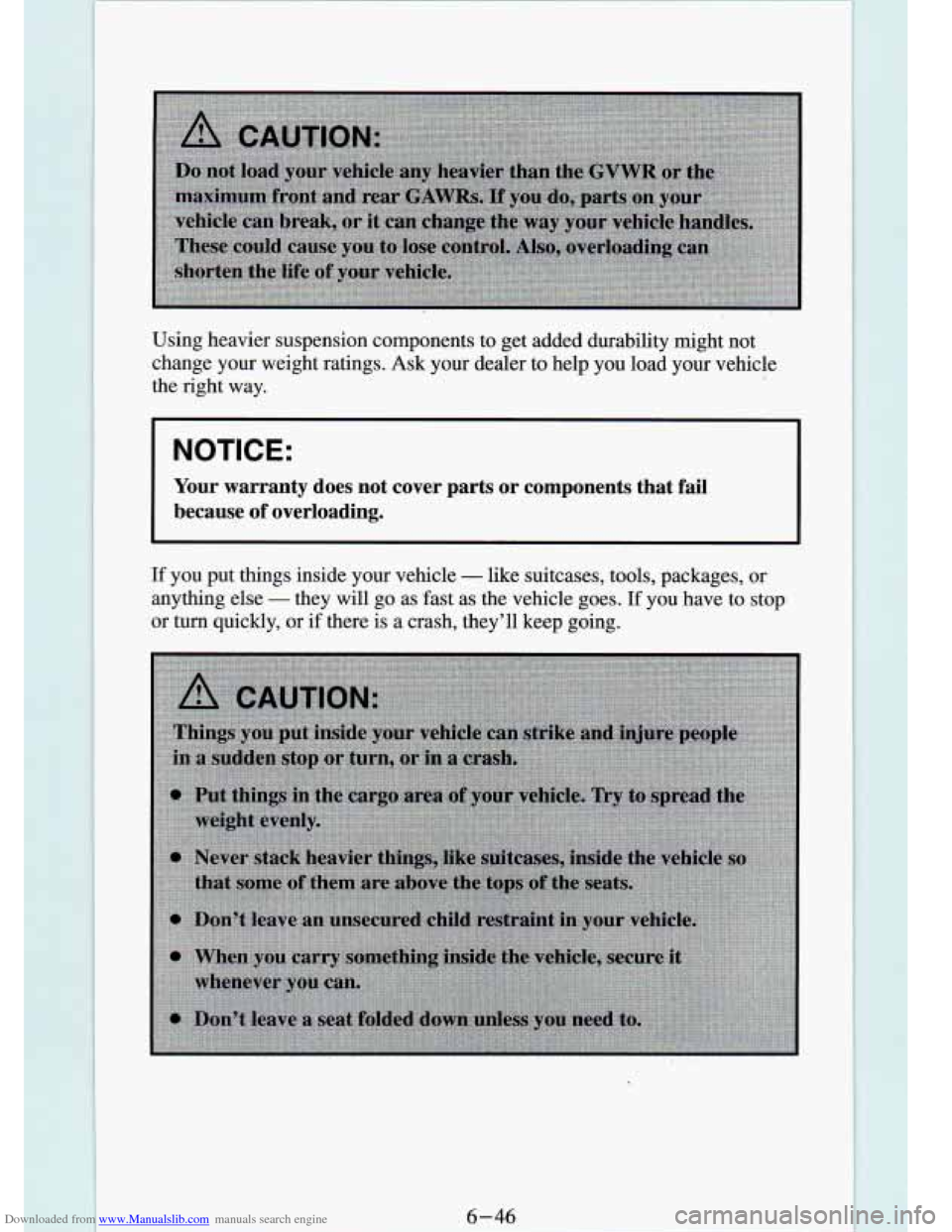
Downloaded from www.Manualslib.com manuals search engine Using heavier suspension components to get added durability might not
change your weight ratings. Ask your dealer to help you load
your vehicle
the right way.
I NOTICE:
Your warranty does not cover parrs QF components that fail
because of overloading.
If you put things inside your vehicle - like suitcases, tools, packages, or
anything else
- they will go as fast as the vehicle goes. If you have to stop
or turn quickly, or if there is a crash, they’ll keep going.
Page 265 of 340
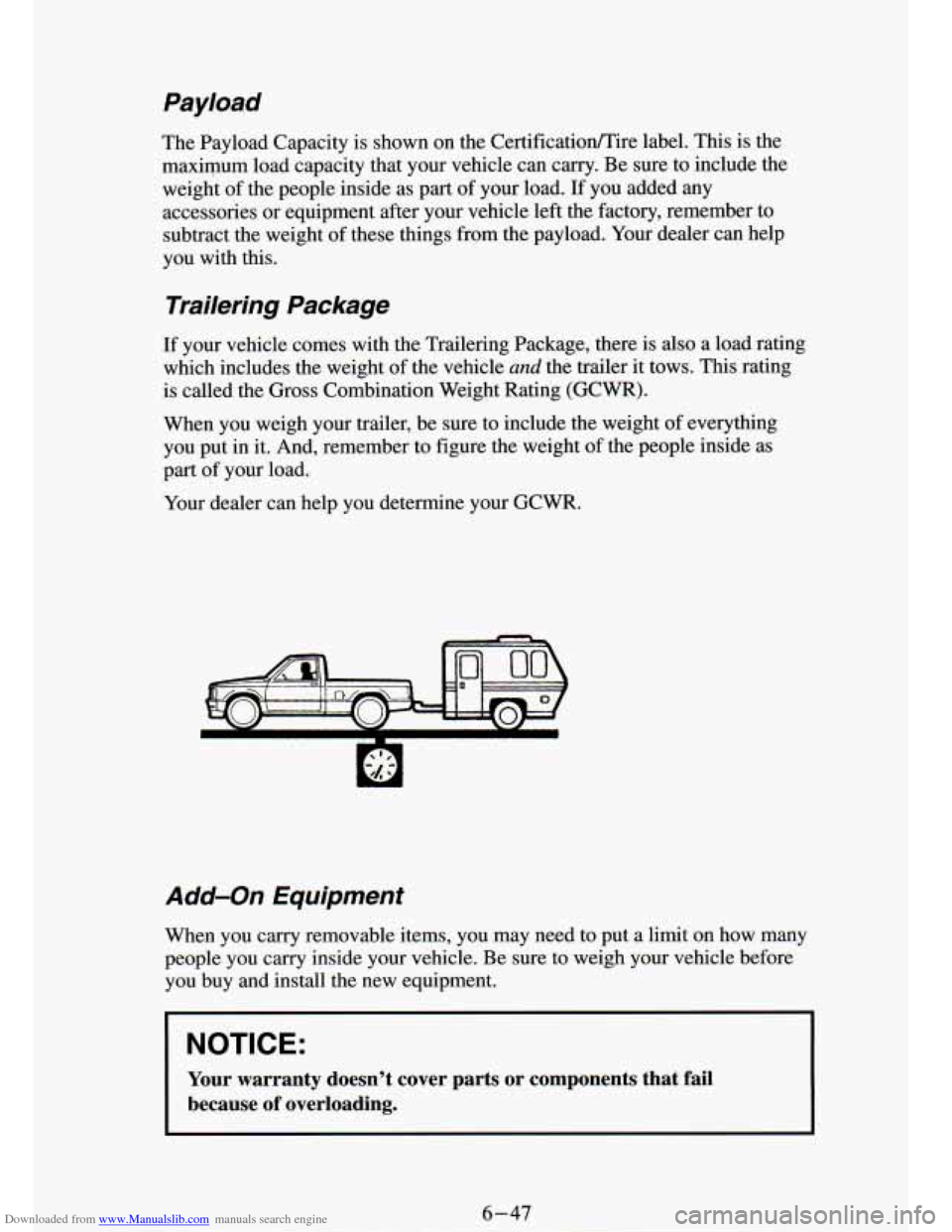
Downloaded from www.Manualslib.com manuals search engine Payload
The iyload Capacity is shown on the Certificatioflire label. This is the
maximum load capacity that your vehicle can carry. Be sure to \
include the
weight of the people inside as part of your load.
If you added any
accessories or equipment after your vehicle left the factory, remember to
subtract the weight of these things from the payload. Your dealer can help
you with this.
Trailering Package
If your vehicle comes with the Trailenng Package, mere is also a load rating
which includes the weight of the vehicle
and the trailer it tows. This rating
is called the Gross Combination Weight Rating (GCWR).
When you weigh your trailer, be sure to include the weight of everything
you put
in it. And, remember to figure the weight of the people inside as
part of your load.
Your dealer can help you determine your
GCWR.
Add-on Equipment
When you carry removable items, you may need to put a limit \
on how many
people you carry inside your vehicle. Be sure to weigh your v\
ehicle before you buy and install the new equipment.
NOTICE:
Your warranty doesn’t cover parrs or components that fail
because of overloading.
Page 266 of 340
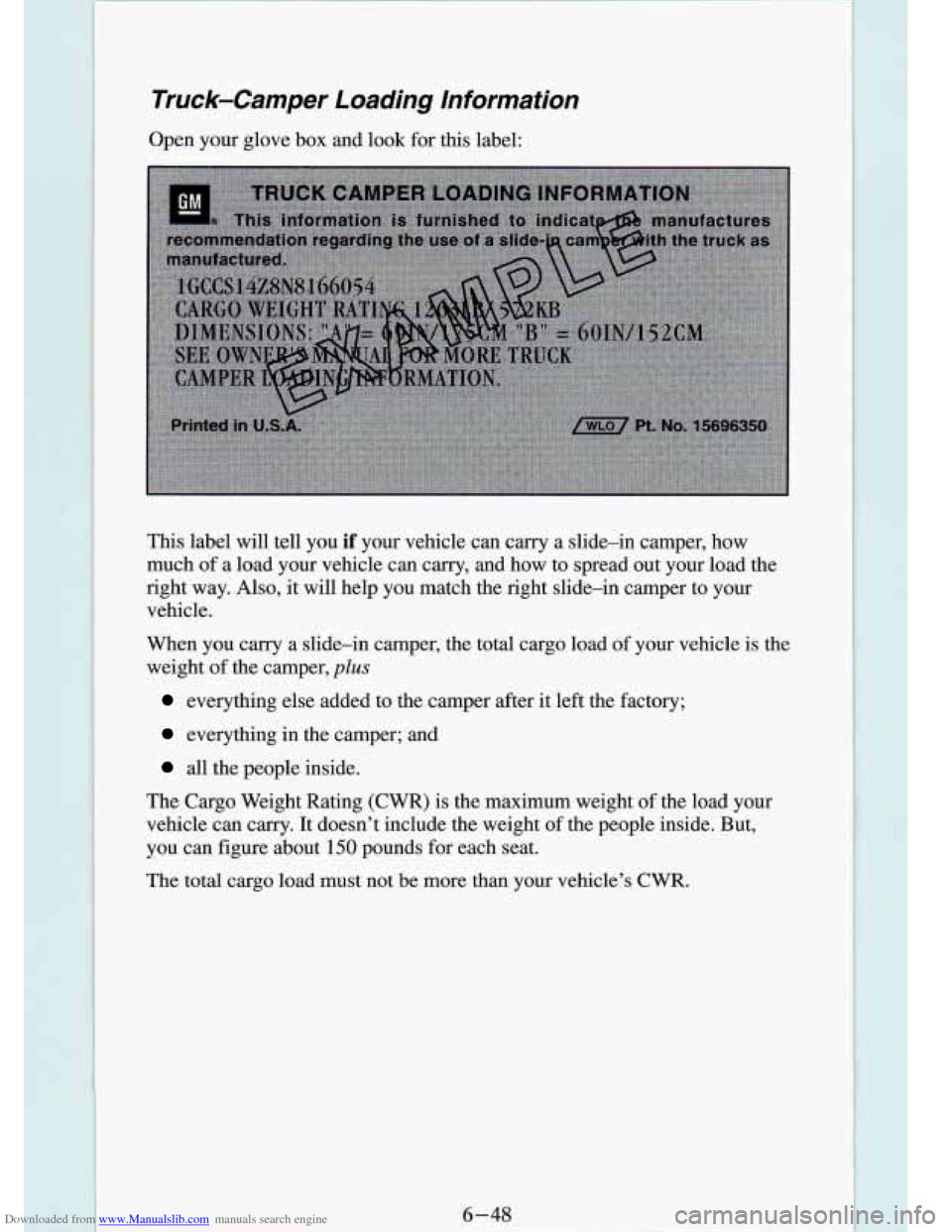
Downloaded from www.Manualslib.com manuals search engine Truck-Camper Loading Information
Open your glove box and look for this label:
This label will tell you
if your vehicle can carry a slide-in camper, how
much
of a load your vehicle can carry, and how to spread out your load the
right way.
Also, it will help you match the right slide-in camper to your
vehicle.
When you carry
a slide-in camper, the total cargo load of your vehicle is the
weight
of the camper, plus
everything else added to the camper after it left the factory;
everything in the camper; and
all the people inside.
The Cargo Weight Rating (CWR) is the maximum weight of the load your
vehicle can carry. It doesn’t include the weight of the people inside. But,
vou can figure about
150 pounds for each seat.
I ne total cargo load must not be more than your vehicle’s CWR.